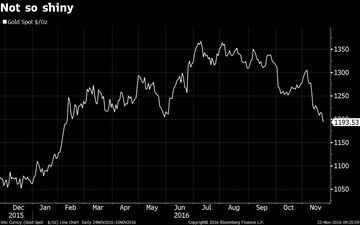Definition of 'Trumpflation'
Trumpflation is the inflation that might appear during Donald J. Trump's U.S. presidential administration. Though Trumpflation is still only speculative, markets have already signaled they believe Trump will spur inflation in the U.S. dollar.
Break Down 'Trumpflation'
Since Donald Trump emerged as the victor of the 2016 presidential election early in the morning of November 9, markets have been strongly indicating that higher inflation is on its way. According to a Bank of America Merrill Lynch (BAML) report released November 10, 2016, rolling eight-week inflows to Treasury Inflation Protected Securities (TIPS), the par value of which is linked to the consumer price index (CPI), hit a record. Ten-year Treasury yields rose 30 basis points to 2.15% between November 8 and November 10, leading to a steeper yield curve, which indicates higher inflation expectations.
There are a number of reasons Trump's policies could cause a shift away from a disinflationary post-financial crisis environment. The president-elect has promised to spend $1 trillion on infrastructure projects over ten years. While he has separately promised to reduce or even eliminate the nation's $19.8 trillion debt, most independent analyses agree that Trump will boost deficit spending. The resulting boost to the economy is likely to spark reflation.
At the same time, Trump's (not entirely consistent) hostility to the current Federal Reserve's accommodative policy indicates that he will shift the burden of stimulus from monetary policy to fiscal policy. That could signal the end to an era of central bank bond-buying (the Fed's quantitative easing program ended in October 2014, but QE continues in Japan and Europe). Forced demand for sovereign debt has pushed down interest rates to the extent that much of the world's sovereign debt carries negative yields.
Trump's other policies are also expected to spur inflation. Tax cuts will likely boost after-tax incomes. Curbs on immigration will likely push wages up. Protectionist policies will likely raise import prices. At the same time, Trump's galvanizing effect on economic nationalists elsewhere in the rich world could see his policies emulated in other major markets.
Trumpflation is not guaranteed to happen. Trends such as continued technological innovation, an aging population and swelling global debt continue to push down prices, as BAML pointed out in an October report. The size of the national debt could also put a damper on the effects of further stimulus, keeping growth and inflation in check. Lacy Hunt, executive vice president at Hoisington Investment Management Co., told the Wall Street Journal on November 16 that from 1952 to 1999, taking on $1.70 in additional non-financial debt would lead to $1 in gross domestic product (GDP) growth. By 2015, the figure had risen to $4.90.
Gold and Trumpflation
Trumpflation Might Not Help Gold if Real Rates Keep Rising
Gold bugs are caught between a shiny rock and an asset inflation can't debase.
 Photographer: Lisi Niesner/Bloomberg
Photographer: Lisi Niesner/BloombergWhat's happened to gold?
Conventional wisdom held that the uncertainty that would follow a Donald Trump victory in the election would be very positive for safe-haven assets like gold, but since Nov. 8 the shiny stuff has fallen by more than 6 percent to below $1,200 per ounce.

Source: Bloomberg
And if gold's a hedge against rampant inflation, wouldn't the imminent installment of the inflation president also prove a boon?
That may be because although fears of (in/de)flation, the disintegration of civilization in general or the European Union in particular, food prices, investor sentiment, and bets on monetary disorder have all taken their turns in being cited as the key factor in gold investment theses, the behavior of real rates has proved far more important in explaining bullion's gyrations.
Following durable goods orders for October that more than lived up to their name and dispelled any notion of election-related uncertainty restraining business activity ahead of the event, the yield on five-year Treasury Inflation-Protected Securities (or TIPS) broke into positive territory, hitting levels not seen since March 16, as gold tumbled.

Source: Bloomberg
Such an observation is hardly novel.
Eddy Elfenbein, portfolio manager at AdvisorShares Investments LLC and founder of Crossing Wall Street, has built a model predicting where gold prices will go based on the deviation of short-term real interest rates from their natural level. The Globe and Mail's Scott Barlow has also explained the relationship between the two assets on a number of occasions.
The thinking here is that the value of a hard asset with a yield of zero (net of storage costs) will be affected by the relative real yield on assets that are considered risk free, an alternative holding. In other words, the so-called opportunity cost of buying gold rises as real Treasury yields increase.
So if you want to know how the president-elect is changing the outlook for gold, looking at inflation-protected Treasury yields instead might prove more useful than searching for nascent signs of Trumpflation.

No comments:
Post a Comment